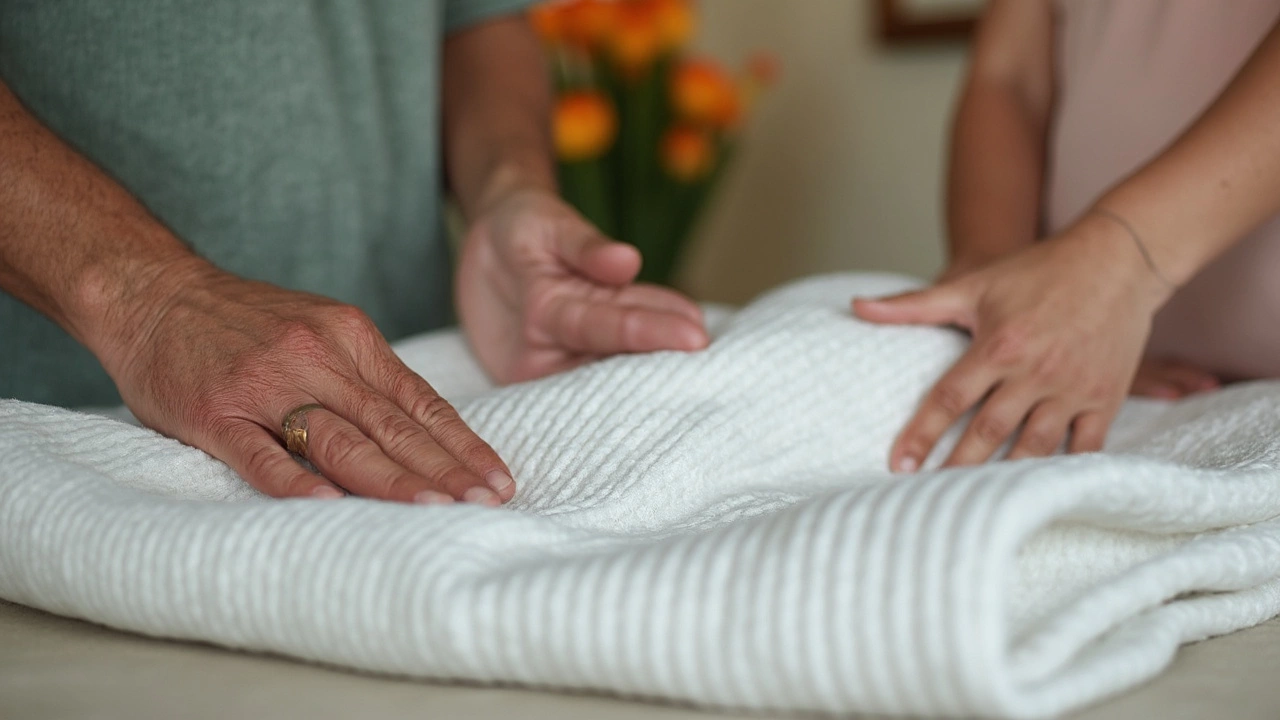Class S Bedding: What It Is and Why It Matters

Shopping for bedding can get confusing fast. Suddenly, you’re staring at terms like ‘Class S’ and wondering what separates a good sheet set from a mediocre one. If you’ve seen Class S bedding pop up in stores or online, it’s not just a marketing trick. It actually means something specific about quality and standards.
Class S bedding refers to a category of bedding that’s been tested for things like safety, durability, and sometimes, comfort. You’ll often see this term show up in hotels, hospitals, or places where bedding has to hold up to repeated use and strict cleanliness rules. If you want bedding that’s strong and long-lasting, this is the kind you want to look for—especially if you’ve ever watched your sheets fall apart after just a few washes.
- Understanding Class S Bedding
- How Class S Bedding Compares to Other Grades
- Where You’ll Find Class S Bedding
- Tips for Picking the Right Bedding
Understanding Class S Bedding
Let’s get real about what class S bedding actually means. This isn’t a made-up marketing label. Class S is an official standard for bedding, mostly recognized in some parts of Europe, especially the UK. The “S” stands for “Standard,” and it covers everything from the fabric strength to flammability and hygiene. Think of it as bedding that’s certified to survive rough handling—like what you’d see in hospitals, hotels, and even care homes.
One of the biggest perks of class S bedding is how tough it is. Compared to regular home bedding, this stuff is built to last. For example, in the UK’s National Health Service (NHS), class S sheets need to handle between 200 and 300 industrial washes before breaking down. That’s way more than your average cotton sheet from a department store, which might start wearing out after 50-100 washes at home.
| Bedding Feature | Class S Bedding | Regular Home Bedding |
|---|---|---|
| Minimum Wash Cycles (Industrial) | 200-300 | Not specified (many below 100) |
| Fabric Blend | Cotton-Polyester Mix | Usually 100% Cotton or Low-Poly Blend |
| Flame Retardancy | Yes (per tested standards) | Rarely |
| Colorfastness | High (for harsh detergents) | Varies, often lower |
| Hygiene Tested | Yes, often standardized | No |
A lot of class S bedding uses a blend of cotton and polyester—usually 50/50—for a reason. This mix keeps the sheets soft enough to be comfortable but tough enough to live through hot washes and tumble dryers on full blast. If you like white, you’ll find most class S sets come in plain white, which makes spotting stains easier and lets you bleach them without wrecking the colors.
- To earn the class S tag, bedding has to pass strict quality control checks for stitching, shrinkage, and even color fading.
- Class S standards can include fire safety tests—some settings require sheets to resist ignition for a few seconds (important for hospitals and care settings).
- Most class S bedding comes in standard UK, EU, or hospital bed sizes. You won’t find as many patterns and colors, but it’s all about function over style.
If you have kids, pets, or run an Airbnb, having class S bedding can be a real game changer. It takes a beating, holds up to spills and stains, and is easier to sanitize than regular sheets. That’s what makes it a favorite in professional environments—and why more people are putting it on their own beds at home.
How Class S Bedding Compares to Other Grades
If you’re trying to figure out where class S bedding sits in the lineup, here’s the scoop. Bedding is usually grouped by grade so buyers know what to expect for quality and durability. You’ll see labels like Class A, Class B, and Class S, especially with commercial or public use bedding. Each has its quirks and real-world impact on how long your sheets last and feel.
Let’s break down the differences in a simple way:
- Class A: This is the basic grade. Think of budget hotels, hostels, or places where cost matters more than anything. It meets the bare minimum for comfort and durability but won't wow you.
- Class B: This is a step up. You’ll find it in mid-tier hotels or as home bedding that can take regular washing. It’s more comfortable and durable than Class A, but not the best out there.
- Class S: This is top-tier. You’ll see it in upscale hotels, hospitals, and any place where bedding needs to be extra tough, safe, and long-lasting. The ‘S’ usually stands for “Superior” or “Sanitary.” It’s tested for stuff like colorfastness, strength, and safety—so it won’t fall apart or fade quickly even with heavy use.
Here’s a quick snapshot of how these grades compare:
| Grade | Where Used | Main Features | Avg. Lifespan (washes) |
|---|---|---|---|
| Class A | Budget hotels, dorms | Basic comfort, low durability | 50-100 |
| Class B | Mid-tier hotels, homes | Better fabric, medium durability | 100-150 |
| Class S | Upscale hotels, hospitals, premium homes | High strength, safety, colorfast, maximum durability | 200+ |
The real win with Class S bedding is longevity and peace of mind. If you’re sick of sheets that pill, thin out, or trade softness for strength, Class S is what you want. Even after hundreds of washes, the fabric holds up, looks fresh, and feels decent. You don’t need to baby these sheets; they’re built to survive hospital-grade sanitizing and commercial laundry cycles.

Where You’ll Find Class S Bedding
If you’ve ever stayed in a hotel and thought, “Wow, these sheets can handle anything,” you were probably sleeping on Class S bedding. This category mostly pops up in places with high turnover or strict hygiene standards. Think hotels, hospitals, dormitories, or cruise ships. You won’t usually find Class S on the fancy bedding shelves at the mall, but peek behind the scenes at places that wash sheets every single day, and it’s pretty much everywhere.
Hotels and guesthouses rely big time on class S bedding because it’s designed for repeated use and regular high-temperature washing. Most hospitality suppliers source these linens from industrial laundry companies or commercial wholesalers. Hospital bedding needs to stand up to heavy cleaning, high heat, and sanitizing chemicals, so Class S fits right in. Some budget motels, hostels, and student accommodations also use it since it lasts longer and saves money over time.
If you want to buy Class S bedding for home, look for suppliers that service businesses instead of regular retail. Search for words like "commercial bedding" or "institutional sheets" online. Some stores now sell to the public as well, and you’ll spot these options in the "contract" or "hospitality" sections of their websites. Expect plain but tough fabrics—usually cotton-polyester blends that stay put wash after wash.
One thing to keep in mind: you’re trading a bit of softness for ruggedness. If you’re after crisp, no-nonsense bedding that can survive kids, pets, or super-frequent washing, Class S is hard to beat. For most people, it’s a game changer the second you get tired of pilling sheets and worn-out pillowcases.
Tips for Picking the Right Bedding
Choosing bedding can feel like a mission, but there are some solid rules that make the search way easier. For starters, always check the bedding label. Look for the category—something like class S bedding—if you want durable, safe, and high-quality sheets. If the label’s missing or vague, move on to the next option. Cheap bedding tends to skip on durability, so you’ll pay more in the long run once it starts fraying or shrinking after a few washes.
If you’re looking for something that lasts, pay attention to these:
- Material: Cotton is king for comfort and breathability. Polyester blends are good for wrinkle resistance and easy care. Bamboo is becoming popular because it’s soft and often hypoallergenic.
- Thread Count: Higher numbers aren’t always better. Most people are happy with 300-500 threads per inch. Above that, it’s more about marketing unless you want hotel-level softness.
- Weave: Percale sheets feel crisp and cool, good for hot sleepers. Sateen feels smoother and warmer, perfect if you get cold at night.
- Certifications: OEKO-TEX and similar marks mean the sheet is made without harmful chemicals.
Here’s a quick look at what people care most about when picking bedding:
| Feature | Percentage of Buyers Prioritizing |
|---|---|
| Material | 62% |
| Thread Count | 20% |
| Ease of Care | 10% |
| Price | 8% |
Worried about allergies or sensitive skin? Pick hypoallergenic bedding. Bamboo and some tightly woven cotton sheets resist dust mites and mold, which is a lifesaver if you wake up congested.
Never forget the return policy. Even expensive bedding can feel wrong on your skin. Shops that let you wash and sleep on the sheets before committing are a real win.
Finally, always check the fit. Measure your mattress—including depth—so you don’t end up wrestling your fitted sheet every laundry day. A snug fit keeps your bed looking sharp and feels better, too.